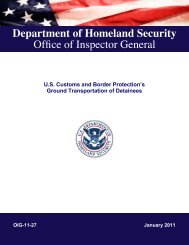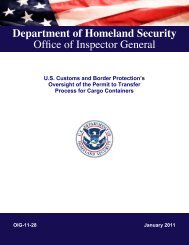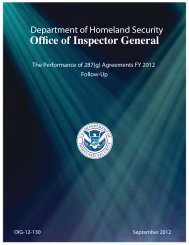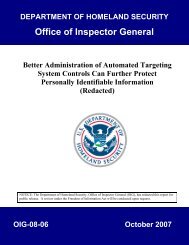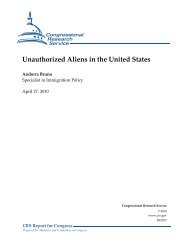Border Security and Unmanned Aerial Vehicles
Border Security and Unmanned Aerial Vehicles
Border Security and Unmanned Aerial Vehicles
You also want an ePaper? Increase the reach of your titles
YUMPU automatically turns print PDFs into web optimized ePapers that Google loves.
CRS-5decides to outfit the Predator B with a synthetic aperture radar (SAR) system. 19 Radarscan produce high resolution imagery in inclement weather. The ability of SAR tofunction during adverse weather conditions sets it apart from optical or infrared systems. 20However, its ability to track moving targets is limited. This limitation can be mitigatedby accompanying SAR with moving target indicator (MTI) radar technology. AddingSAR <strong>and</strong> MTI to the Predator B’s platform could significantly enhance its operationalcapability for border missions. By adding SAR <strong>and</strong> MTI to the UAV platform, however,the costs of using UAVs on the border would increase.How UAVs could be integrated into civilian airspace within the United States is afundamental question that would need to be addressed by the Federal AviationAdministration (FAA) <strong>and</strong> DHS. Integrating UAVs into civilian airspace so that theycould operate safely would require not only the creation of regulatory guidelines by theFAA but also technical developments. Currently, the FAA is working on guidelines forintegrating UAVs into the national air space (NAS). Although there are no guidelines orregulations for incorporating UAVs into the NAS, the FAA has worked closely withgovernment users of UAV technology in developing a certificate of authority (COA) soNAS can be blocked off for exploratory development or operational testing. A primaryconcern of the FAA is whether UAVs can operate in already crowded airspace. Thechallenge, according to FAA spokesman William Shumann is, “to develop vehicles thatmeet FAA safety requirements if they want to fly in crowded airspace.” 21 Before UAVscan be introduced into national airspace, the FAA, DHS <strong>and</strong> other relevant technologyusers will need to address collision-avoidance, communication <strong>and</strong> weather avoidanceissues. 22Issues for CongressCongress will likely conduct oversight of Operation Safeguard before consideringwider implementation of this technology. Additionally, the President’s report to theCongress in April 2004 on use of UAVs for support of homel<strong>and</strong> security missions shouldbe useful to congressional evaluations, especially with respect to the tactical, warning <strong>and</strong>intelligence capabilities of this technology. If implemented, would UAVs simply be usedto monitor the border for illicit activity, or would they be utilized in a more sophisticatedmanner? In the future could UAV imagery be used to develop intelligence products onpatterns <strong>and</strong> tactics used by illegal entrants?19According to General Atomics, the Predator B used during Operation Safeguard was equippedwith E-O, FLIR <strong>and</strong> SAR.20For further information about Synthetic Aperture Radar (SAR) see the following website at[www.s<strong>and</strong>ia.gov/radar/whatis.html]. The SAR system used by some Predators is called theLYNX. The LYNX system can provide photographic images of up to four-inch resolution at amaximum altitude of 40 kilometers in fair weather. For more about the LYNX system see thefollowing website at [http://www.ga.com/news/lynx_sar.html].21Greta Wodele, “Firms to showcase unmanned planes for <strong>Border</strong> Patrol,” National Journal’sTechnology Daily, Aug. 11, 2003.22In Nov. 2003, the FAA, DoD, NASA, <strong>and</strong> six private commercial companies launched AccessFive, a five-year program to address the safety <strong>and</strong> technical concerns associated with usingUAVs in national airspace.



